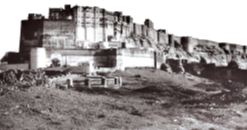Eighteenth Century Political Formations - Worksheets
CBSE Worksheet 01
Eighteenth Century Political Formations
- Murshid Quli Khan was Nawab of
- Deccan
- Awadh
- Punjab
- Bengal
- Influential Rajput families claimed the subadari of the rich provinces of Gujarat and Malwa. Raja Ajit Singh of Jodhpur held the governorship of Gujarat and Sawai Raja Jai Singh of Amber was governor of Malwa. These offices were renewed by
- Emperor Jahangir in 1713
- Emperor Shah Alam II in 1713
- Emperor Jahandar Shah in 1713
- Emperor Ahmad Shah in 1713
Identify the below mention figure

Mehrangarh Fort, Jaipur
Red Fort, Agra
Mehrangarh Fort, Jodhpur
Red Fort, Delhi
Ahmad Shah Abdali had seized the rich province of the
Punjab and Sirhind
Bengal and Orissa
Awadh and Hyderabad
Amber and Nagpur
- Nadir Shah, sacked and plundered the city of Delhi in
- 1739
- 1738
- 1735
- 1740
Match the following:
Column A Column B (i) Subadar (a) a revenue farmer (ii) Faujdar (b) a Mughal military commander (iii) Ijaradar (c) provincial governor (iv) Misl (d) a band of Sikh warriors - Fill in the blanks:
Murshid Quli Khan transferred all Mughal jagirdars to ___________ and ordered a major reassessment of the _________ of Bengal.
- State true or false:
Poona became the capital of the Marathas in the 18th century.
What was the ambition of the Nizam-ul-Mulk Asaf Jah?
Who was Shivaji?
How did Marathas rise to power?
Write a short note on Ahmad Shah Abdali.
How did Sikhs rise as an independent kingdom?
CBSE Worksheet 01
Eighteenth Century Political Formations
Solution
- (d) Bengal Explanation: Murshid Quli Khan, also known as Mohammad Hadi, was the first Nawab of Bengal
- (c) Emperor Jahandar Shah in 1713 Explanation: These influential Rajput families claimed the subadari of the rich provinces of Gujarat and Malwa. Raja Ajit Singh of Jodhpur held the governorship of Gujarat and Sawai Raja Jai Singh of Amber was governor of Malwa. These offices were renewed by Emperor Jahandar Shah in 1713.
- (c) Mehrangarh Fort, Jodhpur Explanation: The following image is of Mehrangarh Fort located in Jodhpur.
- (a) Punjab and Sirhind Explanation: Punjab and Sirhind
- (a) 1739 Explanation: In the midst of this economic and political crisis,vthe ruler of Iran, Nadir Shah, sacked and plundered the city of Delhi in 1739 and took away immense amounts of wealth
(i)-(c), (ii)-(b), (iii)-(a), (iv)-(d).
- Orissa, revenues
True
- He wished to control the rich textile-producing areas of the Coromandal Coast in the east.
- Shivaji was the founder of the Maratha Kingdom.
- With the decline of the Mughal empire at the dawn of the eighteenth century, there was once again the assertion of independence by old and new kingdoms against the Mughals.
- The later Mughals were weak and were compelled by circumstances to grant independence to all new kingdoms.
- Among the new kingdoms, the Marathas were the most prominent and powerful.
- Ahmed Shah Abdali was the independent ruler of Afghanistan. He plundered Delhi and Mathura.
- At this time Marathas too were emerging, powerful in North India.
- They challenged the Afghan viceroy in Lahore and drove him away.
- Thus, the Marathas and not the Mughals were locked in battles against foreign invaders, the Afghans.
- The second battle was fought at the famous battleground at Panipat in 1761. The Marathas were defeated and completely routed.
- During Babur’s reign, Guru Nanak founded the Sikh religion.
- During Jahangir’s reign, Guru Arjun Dev provided protection to Khusrau, Jahangir’s rebellious son.
- In 1606, Guru Arjun Dev was put to death.
- In 1675, the ninth Guru, Guru Teg Bahadur was tortured to death by Aurangzeb for refusing to embrace Islam.
- The execution greatly angered the Sikhs.
- In 1699, Guru Gobind Singh became a deadly enemy of the Mughals.
- He founded the Khalsa (meaning pure), the Sikh military order.
- Its sole purpose was to defend the community from oppression.
- Later in the 18th century, the Sikh kingdom extended from Indus to the Yamuna.
- They united as a free power under Maharaja Ranjit Singh with capital at Lahore in 1799.
